CS224W: Machine Learning with Graphs
Stanford / Winter 2021
08-app
Graph Augmentation for GNNs
Key Idea: Raw input graph ≠ computational graph
Graph Augmentation: 输入数据不一定就是计算时的计算图,可以对图在结构或特征上进行augment定义新的computation graph以便于加速计算或其他目的
-
之前讨论的模型架构的假设一直都是:Raw input graph = computational graph,即训练时不对输入的图结构进行改动
-
Reason for breaking this assumption
-
Features
- The input graph lacks features (输入的图数据可能缺乏一些特征)
-
Graph Structure
-
The graph is too sparse ➡ inefficient message passing (图太稀疏➡消息传递效率低)
-
The graph is too dense ➡ message passing is too costly (图太密集➡消息传递代价高)
-
The graph is too large ➡ cannot fit the computational graph into a GPU (图太大➡GPU Memory不够用)
-
-
Graph Feature Augmentation
Graph Feature Augmentation
-
Case-1: Input graph does not have node features (输入图节点没有特征,也就是只有图结构的信息)
-
Assign constant value to nodes (给节点赋常数值作为初始特征)
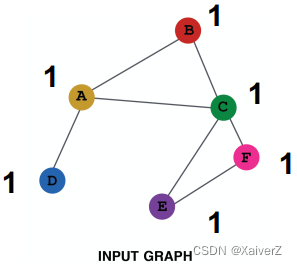
-
Assign unique IDs to nodes (给每个节点一个唯一的ID,而后转成one-hot vector作为初始特征)

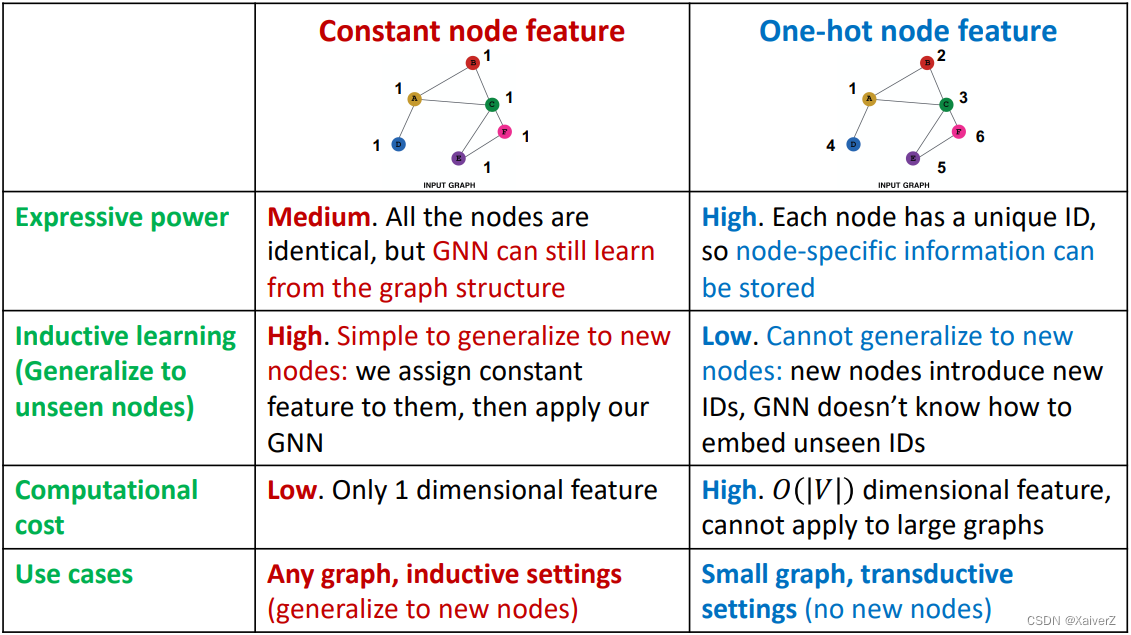
-
-
Case-2: Certain structures are hard to learn by GNN (GNN很难学到某些特定的图结构)
-
Example: Cycle count feature. Can GNN learn the length of a cycle that v 1 v_1 v1 resides in? Unfortunately, no

- v 1 v_1 v1 cannot differentiate which graph it resides in because all the nodes in the graph have degree of 2. The computational graphs will be the same binary tree
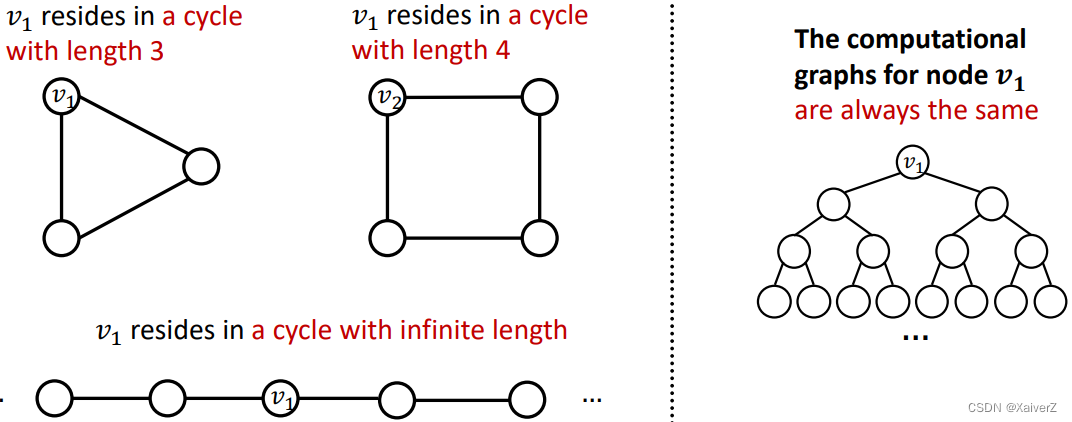
- Solution: 额外加入cycle count作为节点的增强特征
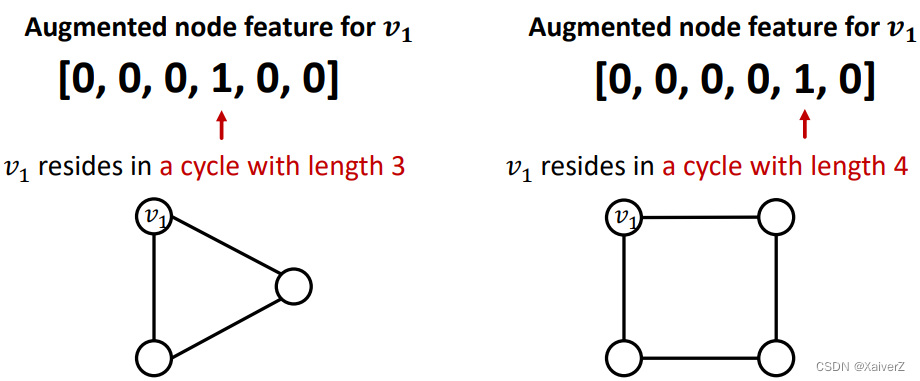
-
Other commonly used augmented features
-
Node degree
-
Clustering coefficient
-
PageRank
-
Centrality
-
…Any feature introduced in lecture 2 can be used
-
-
Graph Structure Augmentation
Graph Structure Augmentation
-
The graph is too sparse ➡ Add virtual nodes/edges (虚拟节点/边)
-
Add virtual edges (加虚拟边)
-
Connect 2-hop neighbors via virtual edges (连接自身与间隔两跳的邻居)
-
矩阵形式实现:
A + A 2 A+A^{2} A+A2
-
-
Add virtual nodes (加虚拟节点)
-
The virtual node will connect to all the nodes in the graph (虚拟点连接图中所有节点)
-
假设在一个稀疏图中,两个节点之间的最短路径为10,这两个节点之间的消息传递就比较低效,要经过10-hop才能交互。当我们用一个虚拟节点连接图中所有节点时,图中所有两两节点之间的最短距离都变为了2 (Node A - Virtual Node - Node B),极大提升了消息传递效率

-
-
-
The graph is too dense ➡ Sample neighbors when doing message passing (消息传递邻居采样)
-
在某一层中,随机采样一些邻居进行消息传递

-
在下一层,可以随机采样另一些不同的邻居进行消息传递
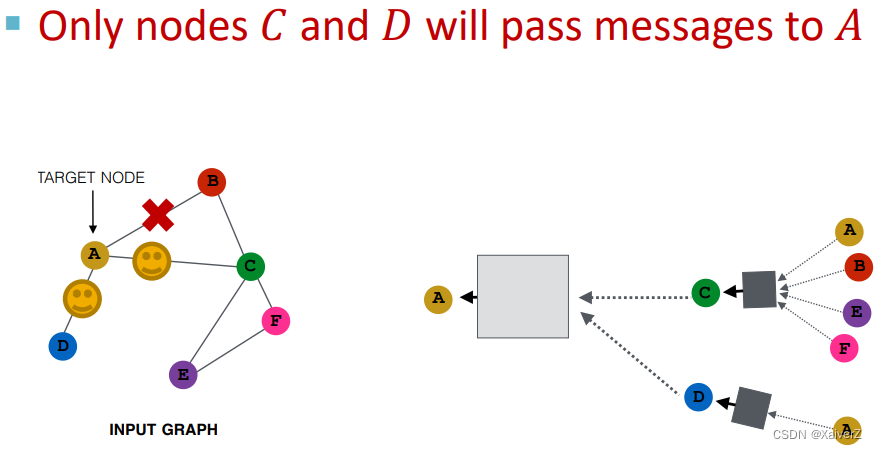
-
使用这种方式,embedding与使用全部邻居计算相差不大,同时极大减少计算开销
-
-
The graph is too large ➡ Sample subgraphs to compute embeddings (采样子图计算embeddings)
Prediction with GNNs
Prediction Heads: Node-level
Prediction Heads: Edge-level
Make prediction using pairs of node embeddings
- Suppose we want to make k-way prediction
y ^ u v = Head e d g e ( h u ( L ) , h v ( L ) ) \widehat{\boldsymbol{y}}_{\boldsymbol{u v}}=\operatorname{Head}_{\mathrm{edg} e}\left(\mathbf{h}_{u}^{(L)}, \mathbf{h}_{v}^{(L)}\right) y uv=Headedge(hu(L),hv(L))
-
Options for Head edge ( h u ( L ) , h v ( L ) ) _{\text {edge }}\left(\mathbf{h}_{u}^{(L)}, \mathbf{h}_{v}^{(L)}\right) edge (hu(L),hv(L))
-
Concatenation + Linear

-
Dot product
y ^ u v = ( h u ( L ) ) T h v ( L ) \widehat{\boldsymbol{y}}_{\boldsymbol{u} \boldsymbol{v}}=\left(\mathbf{h}_{u}^{(L)}\right)^{T} \mathbf{h}_{v}^{(L)} y uv=(hu(L))Thv(L)
该式只适用于二分类,即预测边存不存在(因为点积后为一个值)y ^ u v ( 1 ) = ( h u ( L ) ) T W ( 1 ) h v ( L ) … y ^ u v ( k ) = ( h u ( − ) ) T W ( k ) h v ( L ) y ^ u v = Concat ( y ^ u v ( 1 ) , … , y ^ u v ( k ) ) ∈ R k \begin{gathered} \widehat{y}_{u v}^{(1)}=\left(\mathbf{h}_{u}^{(L)}\right)^{T} \mathbf{W}^{(1)} \mathbf{h}_{v}^{(L)} \\ \ldots \\ \widehat{y}_{u v}^{(k)}=\left(\mathbf{h}_{u}^{(-)}\right)^{T} \mathbf{W}^{(k)} \mathbf{h}_{v}^{(L)} \\ \widehat{\boldsymbol{y}}_{u v}=\operatorname{Concat}\left(\widehat{y}_{u v}^{(1)}, \ldots, \widehat{y}_{u v}^{(k)}\right) \in \mathbb{R}^{k} \end{gathered} y uv(1)=(hu(L))TW(1)hv(L)…y uv(k)=(hu(−))TW(k)hv(L)y uv=Concat(y uv(1),…,y uv(k))∈Rk
该式应用了multi-head attention,能适用于多分类
-
Prediction Heads: Graph-level
Paper : Hierarchical Graph Representation Learning with Differentiable Pooling
Make prediction using all the node embeddings in our graph
- Suppose we want to make k-way prediction
y ^ G = Head graph ( { h v ( L ) ∈ R d , ∀ v ∈ G } ) \widehat{\boldsymbol{y}}_{G}=\operatorname{Head}_{\operatorname{graph}}\left(\left\{\mathbf{h}_{v}^{(L)} \in \mathbb{R}^{d}, \forall v \in G\right\}\right) y G=Headgraph({hv(L)∈Rd,∀v∈G})
-
Options for Head graph ( { h v ( L ) ∈ R d , ∀ v ∈ G } ) \operatorname{Head}_{\operatorname{graph}}\left(\left\{\mathbf{h}_{v}^{(L)} \in \mathbb{R}^{d}, \forall v \in G\right\}\right) Headgraph({hv(L)∈Rd,∀v∈G})
-
Global mean pooling
y ^ G = Mean ( { h v ( L ) ∈ R d , ∀ v ∈ G } ) \widehat{\boldsymbol{y}}_{G}=\operatorname{Mean}\left(\left\{\mathbf{h}_{v}^{(L)} \in \mathbb{R}^{d}, \forall v \in G\right\}\right) y G=Mean({hv(L)∈Rd,∀v∈G})
-
Global max pooling
y ^ G = Max ( { h v ( L ) ∈ R d , ∀ v ∈ G } ) \widehat{\boldsymbol{y}}_{G}=\operatorname{Max}\left(\left\{\mathbf{h}_{v}^{(L)} \in \mathbb{R}^{d}, \forall v \in G\right\}\right) y G=Max({hv(L)∈Rd,∀v∈G})
-
Global sum pooling
y ^ G = Sum ( { h v ( L ) ∈ R d , ∀ v ∈ G } ) \widehat{\boldsymbol{y}}_{G}=\operatorname{Sum}\left(\left\{\mathbf{h}_{v}^{(L)} \in \mathbb{R}^{d}, \forall v \in G\right\}\right) y G=Sum({hv(L)∈Rd,∀v∈G})
-
-
Issue of Global Pooling
-
Global pooling over a (large) graph will lose information
-
Example: we use 1-dim node embeddings
-
Node embeddings for G 1 : { − 1 , − 2 , 0 , 1 , 2 } G_{1}:\{-1,-2,0,1,2\} G1:{−1,−2,0,1,2}
-
Node embeddings for G 2 : { − 10 , − 20 , 0 , 10 , 20 } G_{2}:\{-10,-20,0,10,20\} G2:{−10,−20,0,10,20}
-
非常明显两个图有非常不同的node embedding,它们的结构应该不同
-
但如果我们用global sum pooling
-
Prediction for G 1 : y ^ G = Sum ( { − 1 , − 2 , 0 , 1 , 2 } ) = 0 G_{1}: \hat{y}_{G}=\operatorname{Sum}(\{-1,-2,0,1,2\})=0 G1:y^G=Sum({−1,−2,0,1,2})=0
-
Prediction for G 2 : y ^ G = Sum ( { − 10 , − 20 , 0 , 10 , 20 } ) = 0 G_{2}: \hat{y}_{G}=\operatorname{Sum}(\{-10,-20,0,10,20\})=0 G2:y^G=Sum({−10,−20,0,10,20})=0
-
-
无法区分两图!
-
-
-
Hierarchical Global Pooling
-
Aggregate all the node embeddings hierarchically
-
使用 ReLU ( Sum ( ⋅ ) ) \operatorname{ReLU}(\operatorname{Sum}(\cdot)) ReLU(Sum(⋅))来进行aggregate: 先对前两个节点聚合,再对后三个节点聚合
-
G 1 : { − 1 , − 2 , 0 , 1 , 2 } G_{1}:\{-1,-2,0,1,2\} G1:{−1,−2,0,1,2}
y ^ a = ReLU ( Sum ( { − 1 , − 2 } ) ) = 0 \hat{y}_{a}=\operatorname{ReLU}(\operatorname{Sum}(\{-1,-2\}))=0 y^a=ReLU(Sum({−1,−2}))=0
y ^ b = ReLU ( Sum ( { 0 , 1 , 2 } ) ) = 3 \hat{y}_{b}=\operatorname{ReLU}(\operatorname{Sum}(\{0,1,2\}))=3 y^b=ReLU(Sum({0,1,2}))=3
y ^ G = ReLU ( Sum ( { y a , y b } ) ) = 3 \hat{y}_{G}=\operatorname{ReLU}\left(\operatorname{Sum}\left(\left\{y_{a}, y_{b}\right\}\right)\right)=3 y^G=ReLU(Sum({ya,yb}))=3
-
G 2 : { − 10 , − 20 , 0 , 10 , 20 } G_{2}:\{-10,-20,0,10,20\} G2:{−10,−20,0,10,20}
y ^ a = ReLU ( Sum ( { − 10 , − 20 } ) ) = 0 \hat{y}_{a}=\operatorname{ReLU}(\operatorname{Sum}(\{-10,-20\}))=0 y^a=ReLU(Sum({−10,−20}))=0
y ^ b = ReLU ( Sum ( { 0 , 10 , 20 } ) ) = 30 \hat{y}_{b}=\operatorname{ReLU}(\operatorname{Sum}(\{0,10,20\}))=30 y^b=ReLU(Sum({0,10,20}))=30
y ^ G = ReLU ( Sum ( { y a , y b } ) ) = 30 \hat{y}_{G}=\operatorname{ReLU}\left(\operatorname{Sum}\left(\left\{y_{a}, y_{b}\right\}\right)\right)=30 y^G=ReLU(Sum({ya,yb}))=30
-
-
使用层次池化从而可以区分出两图
-
-
Hierarchical Pooling
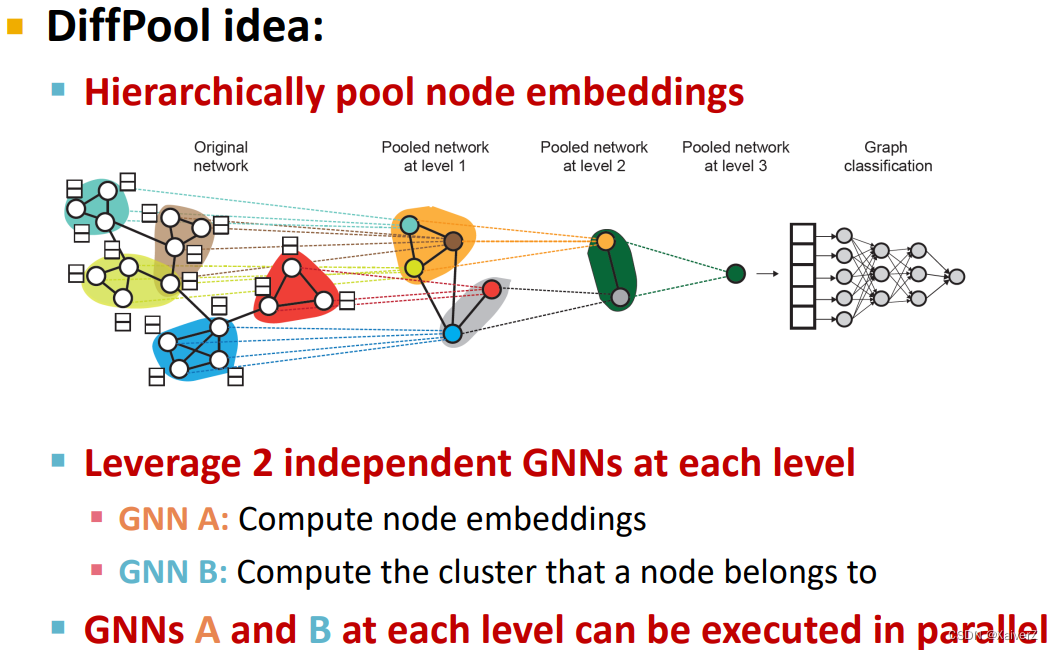
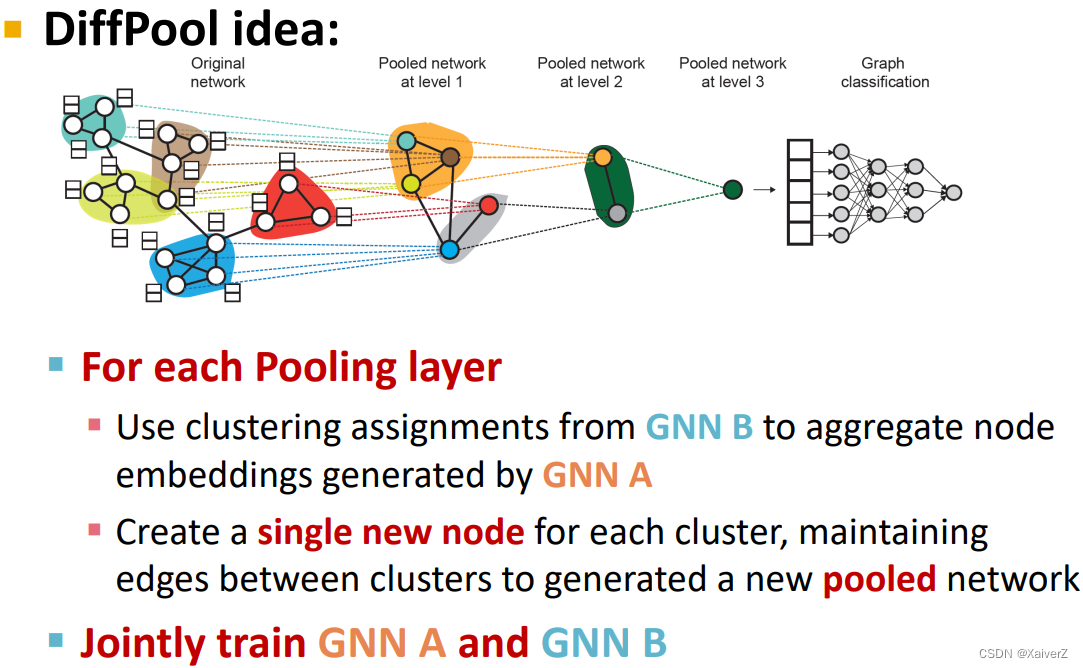
Dataset Split: Fixed / Random Split
Node Classification
-
每个样本(节点)之间不是独立的,由于有连边,所以会互相影响

-
Solution-1: Transductive setting
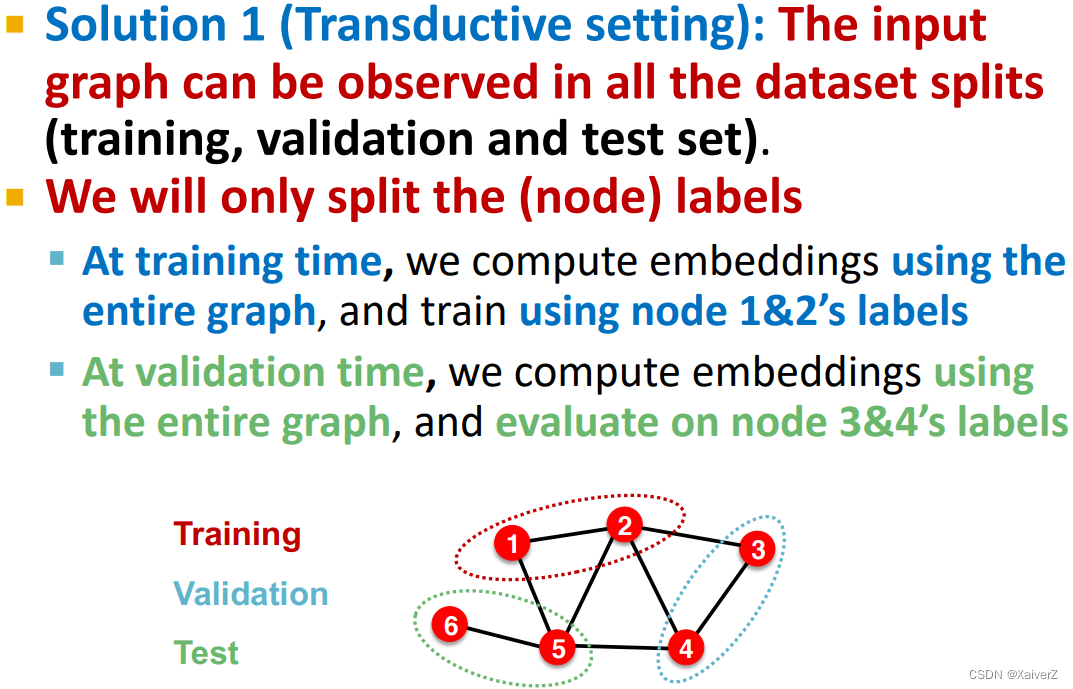
-
Solution-2: Inductive setting
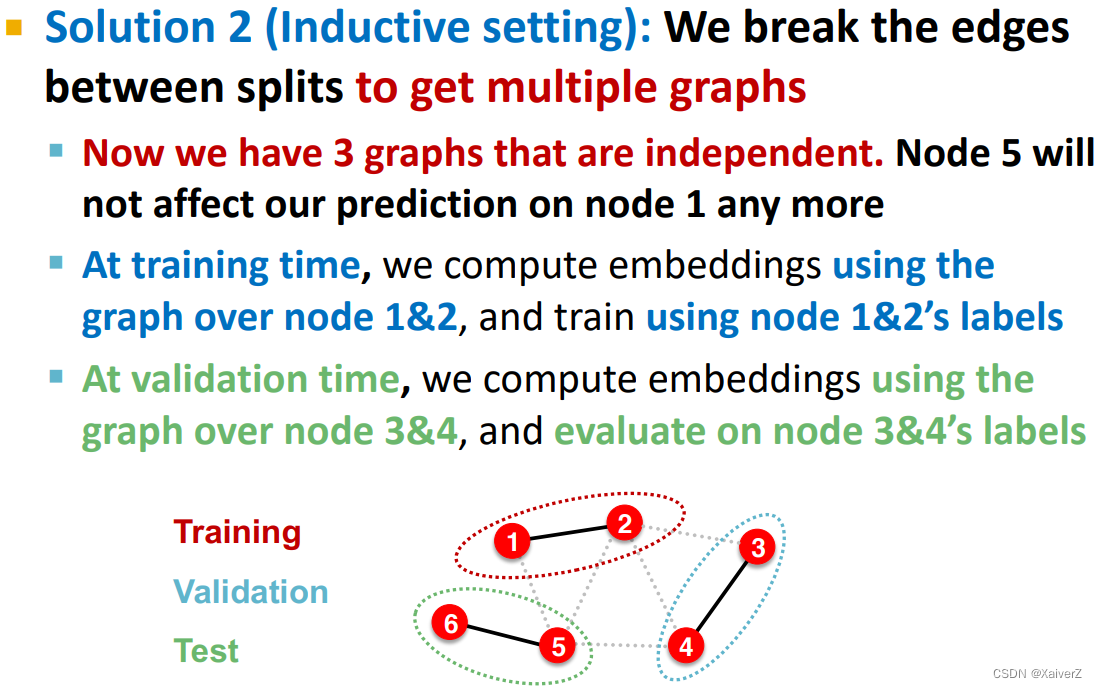

-
Transductive / Inductive Settings
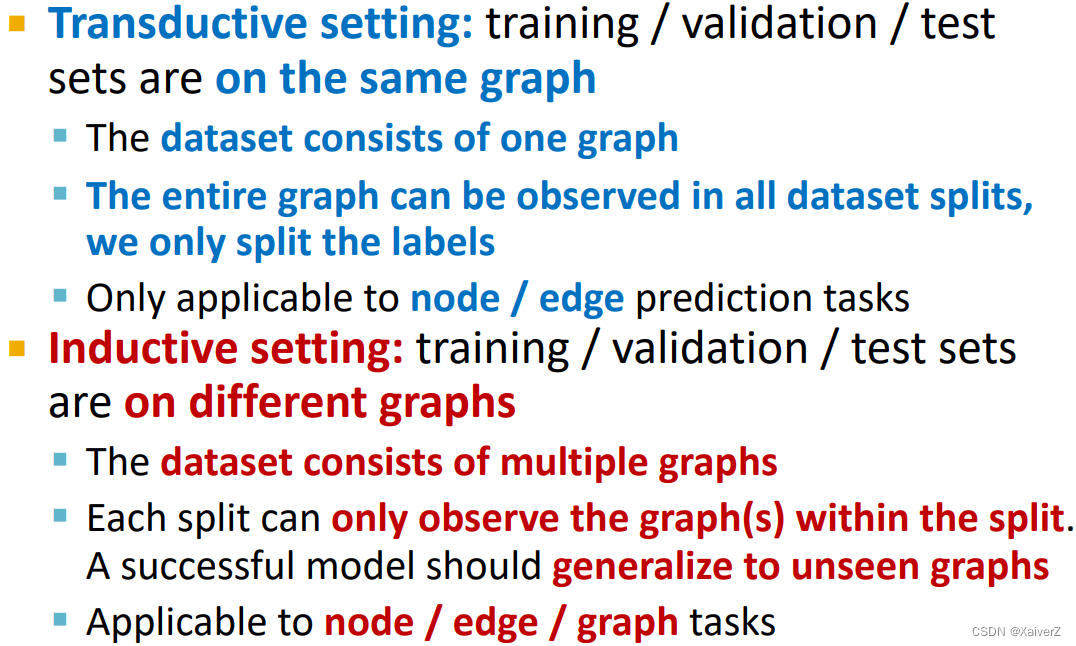
Graph Classification
- 图分类没有类似于节点分类那种数据不独立的问题
Link Prediction
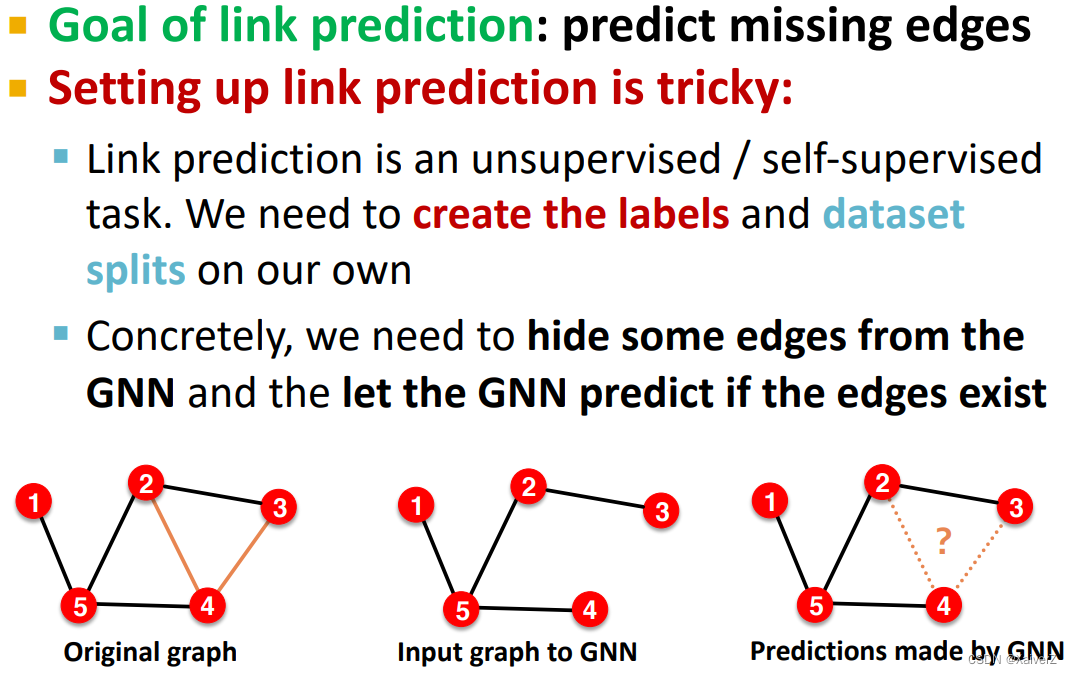
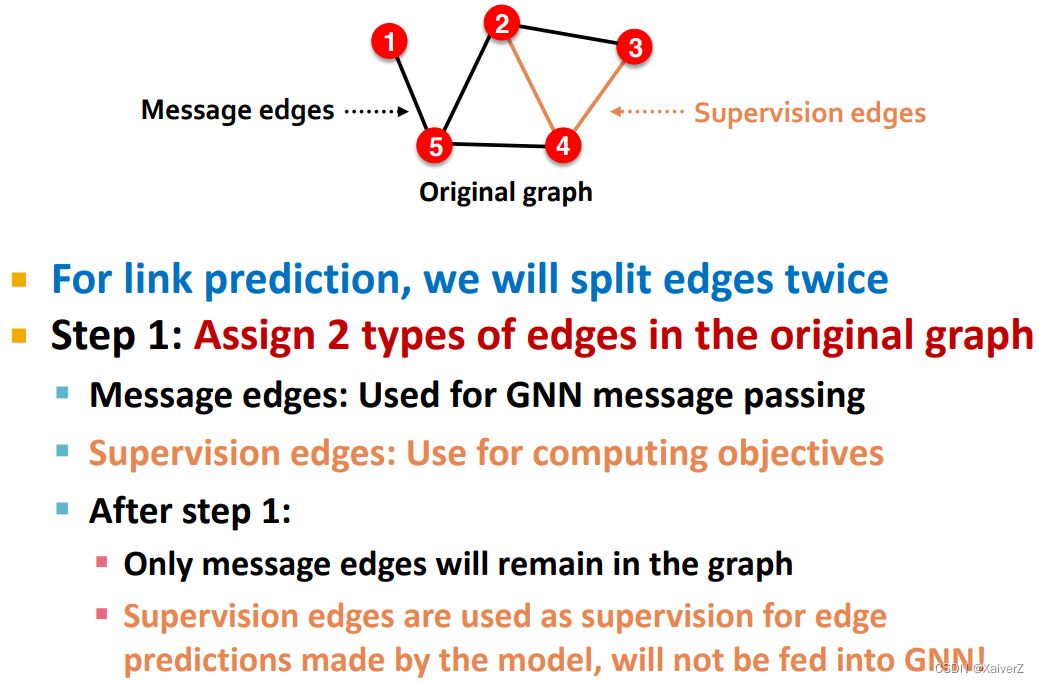
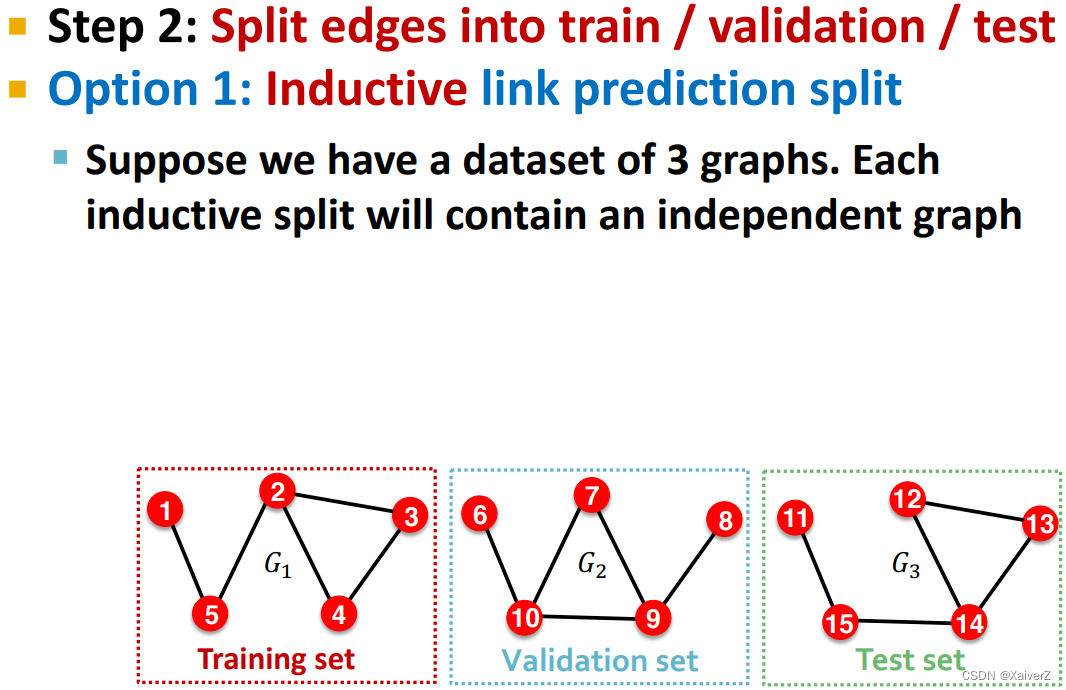

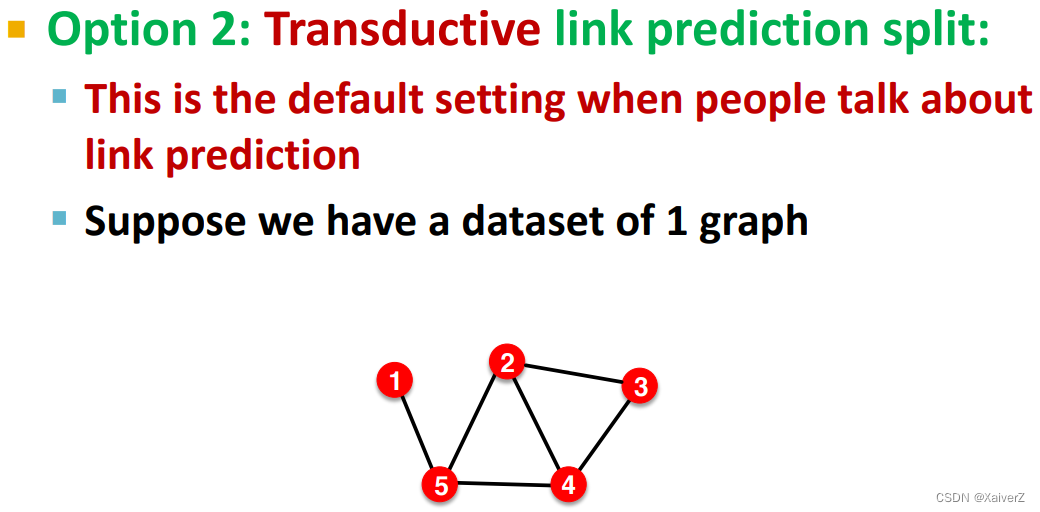
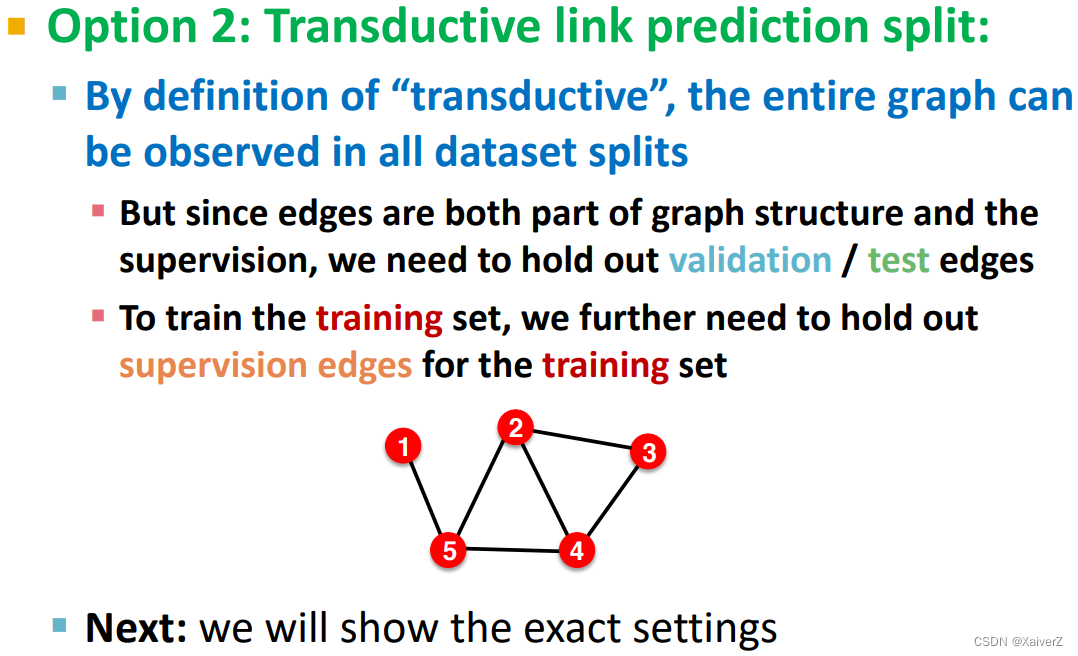
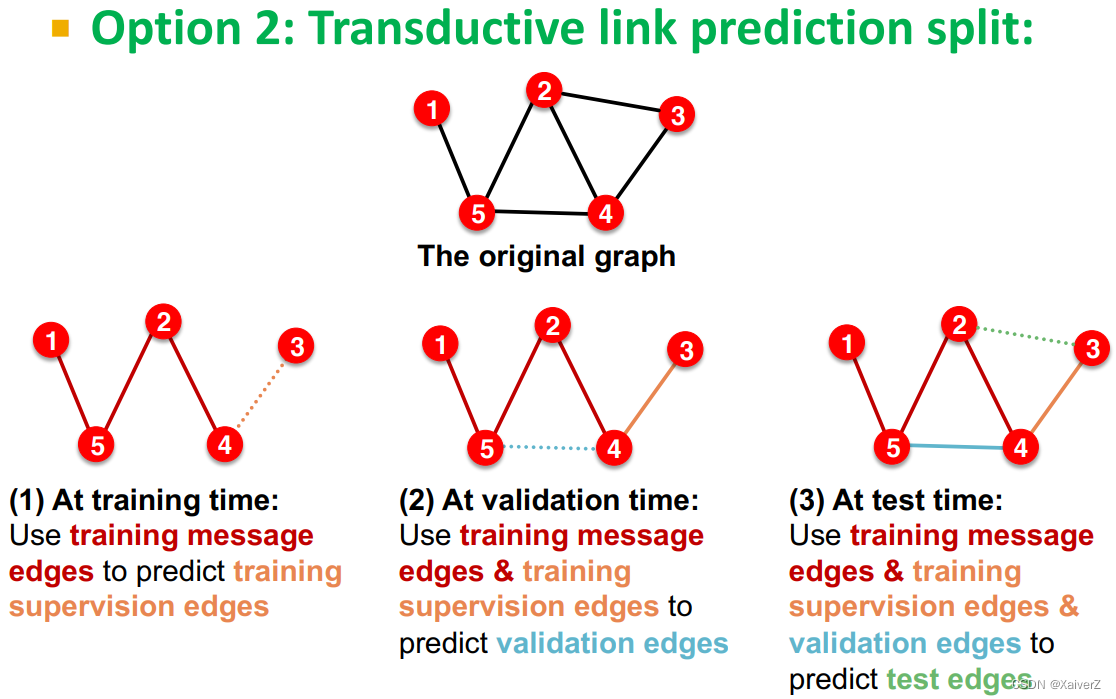

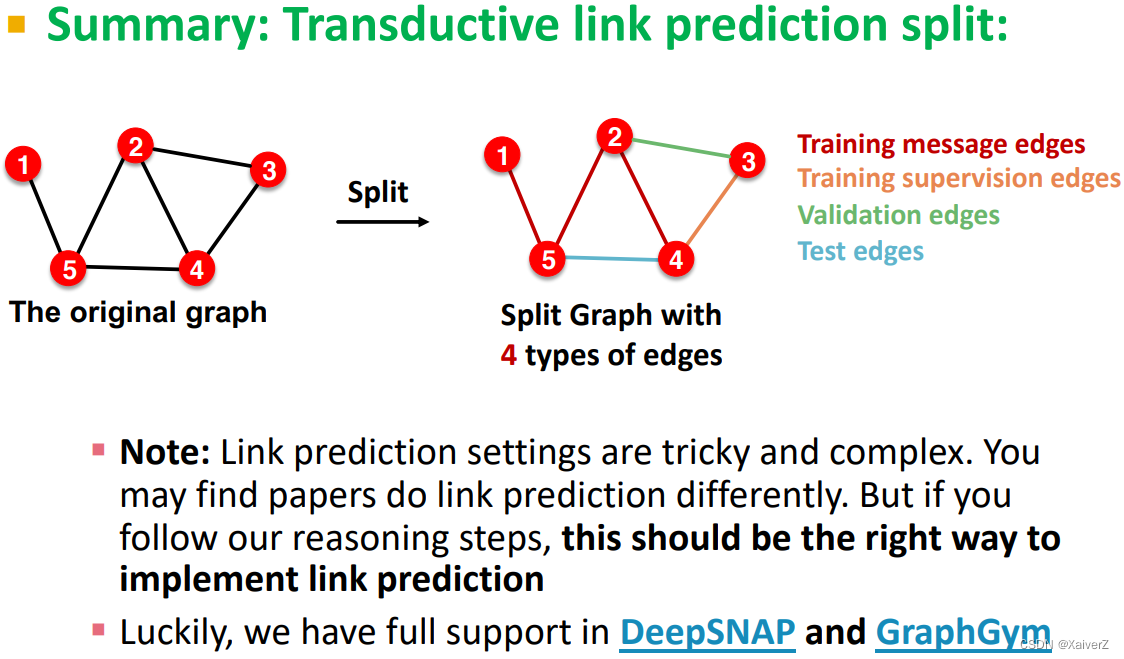





















 643
643











 被折叠的 条评论
为什么被折叠?
被折叠的 条评论
为什么被折叠?








